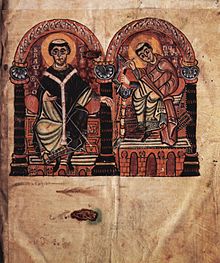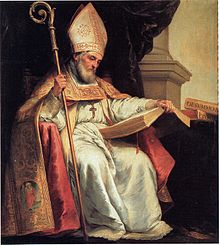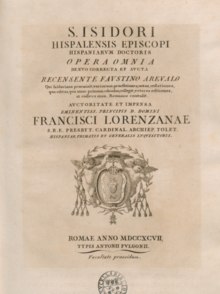Isidore of Seville

Isidore of Seville (Latin Isidorus Hispalensis ; * around 560 in Carthago Nova ( Cartagena ), Spain, † April 4, 636 in Seville ) was the successor of his brother Leander in the office of Bishop of Seville . In his encyclopedia Etymologiarum sive originum libri XX , he compiled the knowledge of antiquity still existing in the west of the Mediterranean around 600 (→ book losses in late antiquity ), linked it with patristicism and made it available in his time. Isidore was one of the most widely read authors of the Middle Ages.
Life
Isidore of Seville came from a family of the Romanized upper class and lived in a time when Eastern Romans and Visigoths were struggling for control of southern Spain. From 600 to 636 he was Archbishop of Seville ( Hispalis ). In 619 he presided over a synod under the Visigothic King Sisebut (to whom he also dedicated his Etymologiae ), in 633 he presided over the 4th Imperial Council of Toledo under King Sisenand .
Isidore of Seville was one of the most important writers and scholars of the early Middle Ages and at the same time can be counted among the last authors of late antiquity because he collected and organized the ancient knowledge that was still available. In its time, the Hispanic Visigoth Empire was characterized by the mixture of Roman and Germanic cultures. Parts of the Iberian Peninsula - including Isidor's birth town Cartagena - were also temporarily under the control of the Eastern Roman emperor after the middle of the 6th century , which made it easier to access ancient works.
Works
Isidore wrote his writings in Latin as the “striking keystone of Latin antiquity” . He dealt with very different areas of knowledge and left behind a large number of works.
Preserved works
- Allegoriae quaedam Sanctae Scripturae (= De nominibus legis et evangelii )
- Chronica maiora . In: Theodor Mommsen (Ed.): Auctores antiquissimi 11: Chronica minora saec. IV. V. VI. VII. (II). Berlin 1894, pp. 391-481 ( Monumenta Germaniae Historica , digitized version)
- De ecclesiasticis officiis
- De fide catholica contra Iudaeos
- De natura rerum
- De ortu et obitu patrum
- De viris illustribus
- De summo bono . Ulrich Zell, Cologne around 1470, not after 1472 ( digitized version )
- Liber differentiarum (= De differentiis verborum )
- Etymologiarum libri viginti
- Liber numerorum
- Historia (de regibus) Gothorum, Vandalorum, Suevorum . In: Theodor Mommsen (Ed.): Auctores antiquissimi 11: Chronica minora saec. IV. V. VI. VII. (II). Berlin 1894, pp. 241–390 ( Monumenta Germaniae Historica , digitized version)
- In libros Veteris ac Novi Testamenti prooemia
- Opera selecta - MS-B-153. Kreuzherrenkonvent, Marienfrede around 1470 ( digitized version )
- Regula monachorum
- Sententiarum libri tres
Etymologiae
Isidor's encyclopedia Etymologiarum sive originum libri XX (short: Etymologiae ) is particularly well known . King Sisebut, to whom it is dedicated in the preface, died in 621, but 15 years later, when Isidore died, the work was still unfinished and was first arranged and published by his pupil Braulio. With this work Isidore shaped the knowledge of his epoch into the early modern period; the first three books, which dealt with the literary trivium (grammar, rhetoric, dialectic) and the mathematical quadrivium (arithmetic, geometry, astronomy and music), were particularly effective . In this way Isidore laid the foundation for every higher education in the Middle Ages. Other of his rediscoveries, such as the ancient atomic theory , initially received no attention.
Isidore's cosmographic explanations in chapters 3–6 and in chapter 8 on the mountains of Book XIV; in the XIII. Book the chapters about oceans, seas, gullies and other things about waters and in the XV. Book about the cities, had a lasting influence on medieval cartography. Its geographical information is then preceded in the XIV. Book with explanations about the circularity of the earth and its T-shaped division. The interpretation of these sentences is controversial: some believe that he thought the earth was flat, while others argue that when he said “circular” he only meant the inhabited part of the earth.
The independent chapter De Medicina describes philosophy and medicine ( secunda philosophia ) as disciplines encompassing the whole human being. In this chapter Isidore goes into the history and the tasks of medicine in detail. To practice it, the doctor must have been trained in all subjects of the trivium and quadrivium , even if medicine itself is not one of the liberal arts .
Historical works
Isidore wrote two historical works: a world chronicle up to the year 615 and a history of the Goths ( Historia Gothorum ), especially of the Visigoth Empire , of which he was a subject. Research has suggested that his Goth history may have been closely based on the lost historiola of Maximus of Saragossa , but this cannot ultimately be proven. Isidore certainly also relied on numerous other late antique chronicles (such as Eusebius of Caesarea , Hydatius of Aquae Flaviae , Johannes von Biclaro and others). In this context, Isidore tried to harmonize the Visigothic empire and the Catholic faith in his history.
effect

Isidore's writings were eagerly copied by monks in the Middle Ages . Some statements by ancient authors are only known through his quotations. His work had an enormous influence on the following generations, both through his biblical exegesis and because of his transmission of ancient knowledge to the world of the Middle Ages. His writings were soon translated into other languages and found wide distribution. Some of Isidore's writings were translated into Old High German . The corpus of these writings is often abbreviated as "Isidore" (see also Mondseer Fragments ).
His reports on the Visigoth Empire established the myth of the superiority of the Goths and later legitimized the Reconquista . Isidore is also responsible for the strong anti-Semitism of the Visigoths after they converted to the Catholic faith. His prediction of an important role for Spain in world affairs became important for the later Spanish self-image.
His “invention” of a universally applicable method of explaining the world by means of finding the truth through language, which he called etymology , was of the greatest general importance for the construction of realities in the next 1000 years . He understood etymology differently from today's linguistics. Isidor's etymology method, which gave his main work the title, can be paraphrased briefly as follows: “If you want to recognize something true in a word about the object denoted by the word, then check the origin of the object, or its effect or the opposite of it whether you find linguistic and / or factual / content-related similarities between word and thing. ”A knowledge of the essence of a term obtained in this way“ etymologically ”is considered more profound than in comparison to knowledge obtained differently (philosophically, scientifically).

Remembrance day and tribute
Isidore is considered to be the last church father in the West. According to the prevailing traditional view, his death is the end of the patristic era .
Isidore of Seville is depicted on the city arms of Seville. The lunar crater Isidorus is named after this church father.
canonization
Isidore was canonized in 1598 . His feast day within the Catholic Church is April 4th ( non-mandatory feast day in the general Roman calendar ). In 2001 he was talked about as patron of the Internet . The Vatican has not yet announced an official patron saint of the Internet. In the same year, the Isidor Award was donated, which was awarded to shareware programs in 2002 and 2003 .
Counterfeit works
There are extensive forgeries from the 9th century that were circulated under the name of Isidors. These fakes had an enormous history of effectiveness. There are reasonable guesswork about authorship but no final evidence. These works now bear the artificial name Pseudoisidor as the author.
literature
- Arno Borst : The Picture of History in the Encyclopedia of Isidore of Seville. In: German Archive for Research into the Middle Ages . Vol. 22, 1966, pp. 1-62. ( online )
- Hans-Joachim Diesner : Isidore of Seville and his time . Stuttgart 1973
- Hans-Joachim Diesner: Isidore of Seville and Visigoth Spain . Berlin 1977
- Brigitte English: The Artes Liberales in the Early Middle Ages (5th – 9th centuries). The quadrivium and the computus as indicators of continuity and renewal of the exact sciences between antiquity and the Middle Ages . Sudhoffs Archive, Supplements 33, Stuttgart 1994
- Peter Habermehl : "The world in a nutshell". Isidore of Seville and the adventures of etymology ( s ), in: U. Peter u. a. (Ed.), Mediengesellschaft Antike? Information and communication from ancient Egypt to Byzantium, Berlin 2006, 51–67.
- Udo Kindermann : Isidore of Seville. In: Wolfram Ax (ed.): Latin teachers in Europe. Fifteen portraits from Varro to Erasmus of Rotterdam. Böhlau, Cologne 2005, ISBN 3-412-14505-X , pp. 273-290
- Hans Philipp , August Schmekel , Arno Schenk : Isidoros 27 . In: Paulys Realencyclopadie der classischen Antiquity Science (RE). Volume IX, 2, Stuttgart 1916, Sp. 2069-2080.
- Wolfgang Schweickard : "Etymologia est origo vocabulorum ...". To understand Isidore's definition of etymology. In: Historiographia Linguistica 12 (1985), pp. 1-25.
- Justo Pérez de Urbel, Hans Pohl, translator : Isidor von Sevilla. His life, his work and his time. Bachem, Cologne 1962
Web links
- Literature by and about Isidore von Sevilla in the catalog of the German National Library
- Works by and about Isidore von Sevilla in the German Digital Library
- Primary texts
- Isidore of Seville: Etymologiae at LacusCurtius
- Isidore of Seville: De natura rerum
- Digitized version of the critical edition of part of a manuscript from De natura rerum of the Bamberg State Library
- Secondary literature
- Isidor von Sevilla in the BBKL , with literature
- Ernest Brehaut: An encyclopedist of the Dark Ages, Isidore of Seville , Columbia University , Burt Franklin, New York 1912
- Catechesis of Pope Benedict XVI on Isidore of Seville , June 18, 2008
- Article by Wolfram Drews on Isidor's relationship with sorcery on Historicum.net
Remarks
- ↑ Max Manitius: History of the Latin Literature of the Middle Ages . CH Beck, Munich 1974, ISBN 3-406-01400-3 , p. 52 ( online in Google Book Search).
- ↑ C. Eisenseer: The life and death of Latin. Approaches to a revitalization. in: Fodor / Hagège / IV: Sprachreform vol. IV. Hamburg 1989, p. 201.
- ^ Edited by Wallace Martin Lindsay , 2 volumes, Oxford 1911; a new multi-volume edition appears in Paris under the direction of Jacques Fontaine since 1981. English translation: Stephen A. Barney, WJ Lewis, JA Beach et al .: The Etymologies of Isidore of Seville . Cambridge University Press, Cambridge 2006. A German translation was provided by Lenelotte Möller : The Encyclopedia of Isidore of Seville . Marixverlag, Wiesbaden 2008, ISBN 978-3-86539-177-3 .
- ↑ Brigitte English: The Artes Liberales in the Early Middle Ages (5th – 9th centuries) . Steiner, Stuttgart 1998, ISBN 3-515-06431-1 .
- ↑ Anna-Dorothee von den Brincken : Space and Time in the History Encyclopedia of the High Middle Ages . In: Historischer Verein für Stadt und Stift Essen (Ed.): Contributions to the history of the city and monastery Essen . tape 96 , 1981, ISSN 0341-9088 , pp. 6-21 .
- ^ Rudolf Simek: Old Norse Cosmography . de Gruyter, Berlin 1990, ISBN 3-11-012181-6 , p. 104 .
- ^ Heinrich Schipperges (†): Isidore of Seville. In: Werner E. Gerabek u. a. (Ed.): Encyclopedia of medical history. De Gruyter, Berlin / New York 2005, ISBN 3-11-015714-4 , p. 683 f.
- ↑ See Jamie Wood: The Politics of Identity in Visigothic Spain. Religion and Power in the Histories of Isidore of Seville. Leiden 2012.
- ^ Hans-Jörg Neuschäfter: Spanish literary history. 3. Edition. Stuttgart, Weimar 2006, p. 3.
- ^ Udo Kindermann : Isidore of Seville . In: Wolfram Ax (ed.): Latin teachers in Europe . Böhlau, Cologne 2005, ISBN 3-412-14505-X , p. 273-290 .
- ↑ Harald Taglinger: Heaven thunder weather. In: Telepolis. February 7, 2001, accessed January 26, 2010 .
- ↑ Peter Wagner: Thekla or Isidor - who hears the complaints of web users? In: Jetzt.de. February 10, 2008, accessed November 18, 2015 .
- ↑ See Isidor Awards 2003: The best shareware on the Internet winfuture.de, June 14, 2003.
| predecessor | Office | successor |
|---|---|---|
| Leander |
Archbishop of Seville 600–636 |
Honorato |
| personal data | |
|---|---|
| SURNAME | Isidore of Seville |
| ALTERNATIVE NAMES | Isidorus hispalensis |
| BRIEF DESCRIPTION | Bishop of Hispale; Author of Latin etymologiae and exegetical texts |
| DATE OF BIRTH | around 560 |
| PLACE OF BIRTH | Cartagena |
| DATE OF DEATH | April 4, 636 |
| Place of death | Hispale, today Seville |

